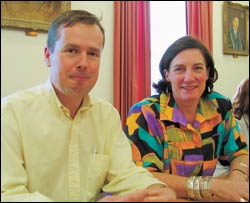Contraceptive revolution: volunteers needed
17 November 2003
New contraception: Dr Richard Anderson and Prof Zephne van der Spuy at the press conference.
The days of women suffering from premenstrual syndrome (PMS) and shouldering the responsibility of contraception may be a thing of the past if two studies in UCT's department of obstetrics and gynaecology are anything to go by.
At a recent press conference, head of department Professor Zephne van der Spuy announced the research group's intention to test a non-hormonal contraceptive for women and hormonal contraceptive alternatives for men
.UCT's team (with Van der Spuy as principle investigator) forms part of the Contraceptive Development Network, a research group established about ten years ago.
With its head office based in Edinburgh and funded by the Department for International Development in the United Kingdom and the Medical Research Council (UK), the Network has centres in Shanghai, Hong Kong and Sagamu (Nigeria).
Although a number of projects have already been completed in this collaborative network, the present studies represent a further development in both male and female contraception.
The first study investigates the use of a non-oestrogen containing pill and compares it directly with the progesterone-only pill, which is the usual choice for women wishing to use a non-oestrogen pill. The use of an anti-progesterone hormone makes the lining of the uterus unfavourable for pregnancy while also preventing ovulation.
"We want a pill that is effective, that eliminates the side effects of oestrogen and then allows women not to have periods," explained Van der Spuy. "This will be a phenomenal advancement for female contraception."
Twenty women are needed to take part in the six-month study (11 have already been recruited). Healthy women wishing to volunteer to take part in the clinical trials should be between 18 and 40 years, sexually active and not weigh more than 70kg.
"Volunteers should not have used hormonal contraceptives for at least three months, should not be breastfeeding and should have no medical conditions such as diabetes or high blood pressure," she added. The second study compares different hormonal treatment regimens for contraception in healthy men. Previous work within the network has demonstrated the efficacy of a combination of testosterone and progestagen as a contraceptive agent in men.
In this study, which requires 30 male volunteers and runs over a year, the sperm count is monitored to assess the effectiveness of the treatment.
A progestagen implant, no bigger than a matchstick, is inserted under the skin of a volunteer's upper arm. This implant is responsible for the suppression of the function of the testes.
A second implant of testosterone (about the size of a rice grain), is inserted under the skin of the stomach and is responsible for replacing this hormone.
According to Dr Richard Anderson, an obstetrician gynaecologist who works in the network in Edinburgh and who visited Cape Town to audit the practice, this form of contraception has modest side effects and sexual function remains normal.
"The process is completely reversible, meaning the implants can be removed and fertility will return to normal after a couple of months."
Already two suitable volunteers are taking part in the study. Van der Spuy and her colleagues are looking for healthy men between the ages of 18 and 45 years who would be required to visit the team every six weeks to have blood taken and produce a sperm sample.
In response to a journalist enquiring about the remuneration (or other benefits) received by male volunteers taking part in the study, Van der Spuy quipped: "They receive a warm glow. They are truly contributing to the future of contraception."
If you are interested in helping with this research or would like more information please contact Sisters Elzie Klopper (female study) or Anne Hoffman (male study) on (021) 404-3074 or (021) 406-6150 or e-mail eklopper@uctgsh1.uct.ac.za or ahoffman@uctgsh1.uct.ac.za
 This work is licensed under a Creative Commons Attribution-NoDerivatives 4.0 International License.
This work is licensed under a Creative Commons Attribution-NoDerivatives 4.0 International License.
Please view the republishing articles page for more information.










